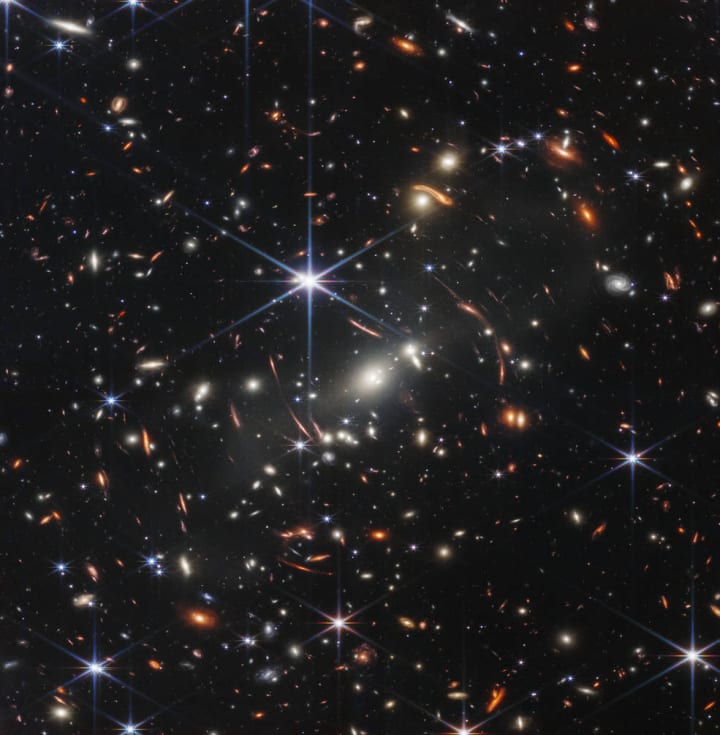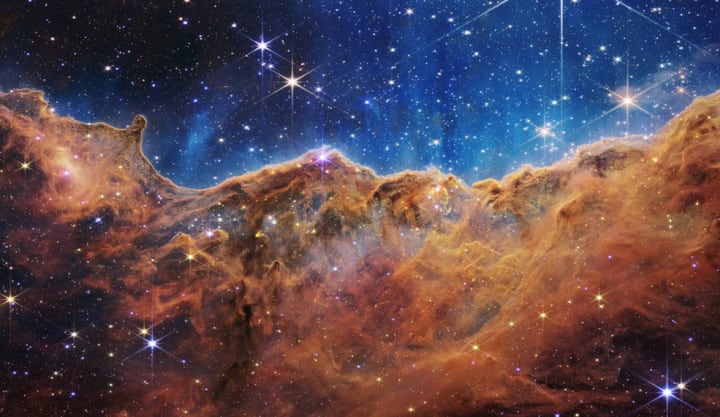JAMES WEBB SPACE TELESCOPE PHOTOS ARE SPECTACULAR
The James Webb Space Telescope revealed its first four images this week. Find out what these images depict and their significance in understanding the universe and humanity’s place within it.

I’ll admit I’d been feeling a little trepidation about the new James Webb Space Telescope. I couldn’t help reflecting back thirty years to the launch of its predecessor, Hubble.
The original deployment of the Hubble Space Telescope was less than a triumph. Its first images outperformed ground-based telescopes, but they weren’t as sharp as everyone expected.
Hubble’s main parabolic mirror was off by just 2 microns. That was enough to give it a reputation as a billion dollar boondoggle, until astronauts doing a spacewalk adjusted the optics.
FIRST IMAGES ARE NOTHING SHORT OF AWE-INSPIRING
I doubt I was the only one half-expecting a repeat of what came to be known as the “Hubble Trouble.” However, Webb (we’ll have to get used to calling it that) proved doubting Thomases like me spectaculary wrong this week.
Webb’s first images are nothing short of awe-inspiring. Considering that this is the first time anyone has unfolded a reflector telescope in space, the new space telescope is a stunning accomplishment.
An international committee of representatives from NASA, the European Space Agency and the Canadian Space Agency selected four of the telescope’s images to release. NASA presented them at a press conference at the Goddard Space Filght Center on Tuesday.
By now, most readers will have caught a glimpse of all four. I’ll also share them here, along with some interpretation of why they’re as meaningful as they are beautiful.
STEPHAN’S QUINTET
Let’s start with a group of galaxies called Stephan’s Quintet, discovered by Edouard Stephan in 1877. If your family celebrates Christmas and has the same tastes as mine, you likely watch the movie It’s a Wonderful Life every holiday season.
I mention that because, in the film, the director used an image of Stephan’s Quintet to represent the archangels who watch over Jimmy Stewart’s troubled character. Webb presents Stephan’s Quintet in stunning new detail.

This image of five nearby galaxies in a visual grouping is the James Webb Space Telescope’s largest image so far. It conists of 150 million pixels drawn from nearly 1,000 individual images.
It’s called a “visual grouping” because only four of the galaxies are close to one another. The one at far left just happens to be in our line of sight at 40 million versus 290 million light-years from Earth.
The level of detail exceeds anything astronomers have seen before. The galaxies it depicts are interacting and merging.
The image shows scientists how stars form out of galaxy interactions. It also shows the distribution of gases within each galaxy in fascinating detail.
We can also see outflows from a black hole with remarkable clarity. These combined features enable cosmologists to learn more about how galaxies evolve. Better understanding the mysterious self-organizing properties of galaxies helps them piece together the story of our universe and humanity’s place in it.
SMACS 0723 – PRESIDENTIAL FAVOURITE\
Astronomers call the galaxy cluster in our next image SMACS 0723. If you held a grain of sand at arm’s lenght, that’s how much of the night sky this photo represents. Yet it includes thousands of galaxies.

SMACS 0723 is the James Webb Space Telescope’s most famous image because President Biden unveiled it the night before the press conference. It’s the deepest and sharpest infrared image of the distant universe in history.
When we look out into space, we also look back in time. That makes this image the most detailed view of the early universe astronomers have ever seen.
The youngest galaxies in this image take us back about 13 billion years to within a billion years of the big bang. Studying these galaxies enables scientists to learn more about the compositions, ages, masses and histories of each of galaxy – “unravelling the mystery that all started with the big bang.” (How cold I resist?)
CARINA NEBULA
This third image we’ll review captures a region in space that astronmers call NGC 3324. It’s a young, star-forming structure in the nearby Carina Nebula.

Photo Credit: NASA, ESA, CSA and Space Telescope Science Institute
At first glance, viewers tend to think this is some sort of mountain range. The image has earned the nickname Cosmic Cliffs as a result.
The height of what looks like some sort of escarpment is 7 light-years in height. It’s really the edge of an enormous, gas cavity within NGC 3324.
Above these cliffs, there’s a bubble in the centre of which massive, hot young stars have formed. Their ultraviolet radiation and stellar winds formed the gaseous cavity.
The way stars from is another puzzling aspect of the way the universe seems to arrange itself. Stars condense out of these clouds of gas and dust.
The stars begin to spin, which creates a disk around them like an old-school vinyl record. Planets form out of the debris within these disks.
Images like Cosmic Cliffs will enable astronomers to discover the factors that drive how many stars emerge in a particular area of space. They’ll also help explain why stars vary in mass, which determines their life cycle and final fate.
SOUTHERN RING NEBULA
Speaking of the final fate of stars, our last image is of the Southern Ring Nebula, which is about 2,500 light-years from earth. It’s a side by side camparison images taken by two of Webb’s cameras.

The subject is a planetary nebula. That’s a shell consisting of the gas and dust emitted by a dying star.
Astronomers couldn’t see the details revealed in this image before the James Webb Space Telescope captured them. These details show scientists they ways in which stars change the environment around them as they evolve.
If you look closely, you’ll see that there are two stars in the center of the nebula, one much brighter than the other. The dimmer of the two emits all the gas and dust.
These binary stars determine the features of the region surrounding them. Until they saw the image on the right, astronomers didn’t realize that the dimmer star is surrounded by dust.
The brighter star is younger than the dimmer one. In time, it too will probably give off a separate planetary nebula.
At the moment, the brighter star’s gravity shapes the nebula’s appearance. The two stars are in a very tight orbit and their motion creates a stirring vortex causing the nebula’s irregular shapes and arrangements.
Dying stars emit a series of gaseous shells. Studying each shell enables scientists to understand the history of a star system.
The gas and dust of each shell alter the region around the star, forming what scientsts call ther interstellar medium. The interstellar medium meanders through deep space, eventually becoming part of new stars and planets.
The Southern Ring Nebula will gradually disperse over the next few thousand years. At that point, we won’t see any trace of it.
These four images are only a small sample of what the James Webb Space Telescope has already achieved in its early days of operation. They’re an entralling debut of a planned five-to-ten-year mission.
In fact, because of its near-flawless launch and deployment, Webb saved a great deal of fuel. So NASA now believes the telescope will far exceed its estimated one-decade lifespan.
We can look forward to many more magnificent images to admire. Beyond that, science will move closer to piecing together the origin of our universe, the formation of stars and galaxies and how a stellar life cycles affects surrounding regions in space.
We always have more to learn if we dare to know.
Learn more:
NASA Reveals Webb Telescope’s First Images of Unseen Universe
First Images from the James Webb Space Telescope
Webb Telescope Optics Meet Expectations
James Webb Telescope Unfolds Its Mirror
About the Creator
David Morton Rintoul
I'm a freelance writer and commercial blogger, offering stories for those who find meaning in stories about our Universe, Nature and Humanity. We always have more to learn if we Dare to Know.






Comments
There are no comments for this story
Be the first to respond and start the conversation.